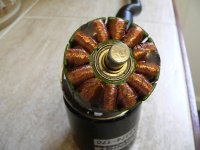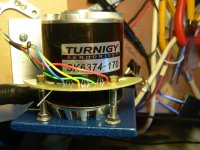Ysterday I had my first problem with fitting Hall sensors to an outrunner. So far I've done several low Kv wound, wye connected motors, with internal Hall sensors fitted in every fourth slot (so 120 degree spacing - these were 12 slot stator, 7 pole pair rotor, motors). All have worked very smoothly with masses of low speed torque.
My milling machine has been running on a Turnigy Aerodrive SK6474 - 170 motor for over a year now, being driven by a cheap RC ESC. It's run faultlessly, but I've often wished for a little more spindle speed, which means upping the voltage to beyond that which a cheap RC ESC will run at. This meant fitting Halls to the motor so I could run it from a spare XieChang controller and a higher voltage power supply. I thought this was going to be a doddle, so fitted Halls as I've done several times before, like this:

You can just see the three Hall sensors set into slightly widened stator slots and glued in with epoxy.
I hooked everything up, only to find that the motor ran as rough as a badgers arse. The thing sounded dreadful, would trip the controller if the throttle was turned too fast or any sort of load was applied. Not only that, but it sounded like it had a misfire at some speeds, with the controller apparently just cutting out for a fraction of a second, fairly randomly. I suspected a dodgy sensor connection, or a bit of interference, so hooked it up to the 'scope. All the Hall signals looked fine, no matter what I did with wiggling wires or whatever, so it didn't look as if the problem was a poor connection or interference.
The motor is stock, so still connected as delta. This made me wonder whether my good fortune with all the other motors might have been because they were all connected wye. Unfortunately, I didn't want to reconfigure this one to wye, as I needed the higher Kv from delta to get the spindle speed I was after. I decided to do an experiment with variable Hall timing to see if this made a difference, using the idea that gwhy! had for fitting Halls. It was an hours work to make up a simple PCB to hold three sensors at the right spacing:
plus another half hour this morning to mod the milling machine motor mounting plate to hold the PCB:

After a bit of playing around, I found that the roughness and cutting out problem was indeed caused by the Hall timing being out. This motor doesn't like running on internal sensors at the neutral position, as I needed to shift the timing by around 10 degrees from neutral (physical, ~ 70 degrees electrical) to find a point where the motor would run smoothly and accelerate cleanly .
It seems that fitting the Halls externally may well be the best way to do it for bigger, delta connected, motors, so this might be a useful tip for those looking to add Halls to standard, unmodified, outrunners.
Jeremy
 .
.


